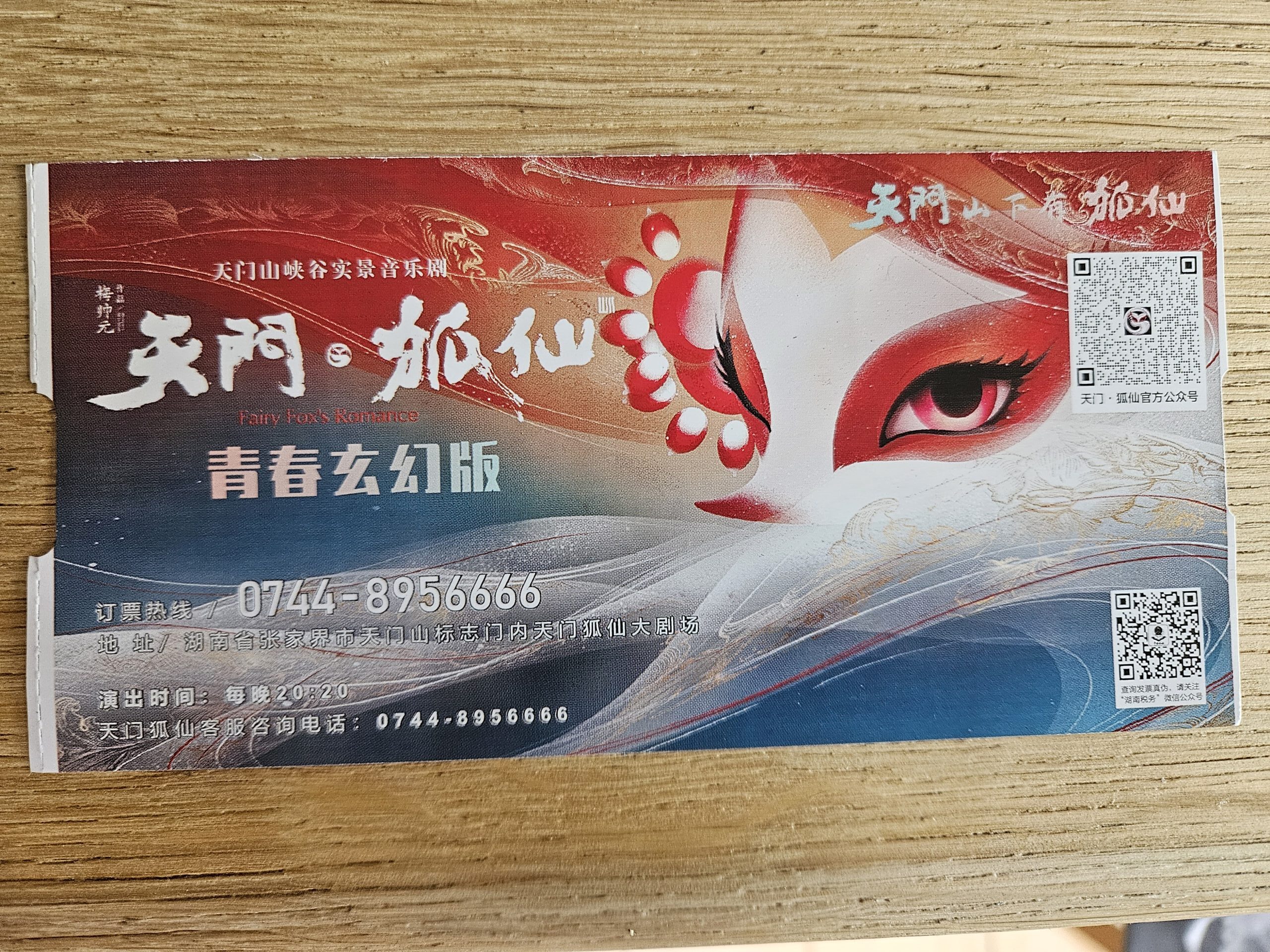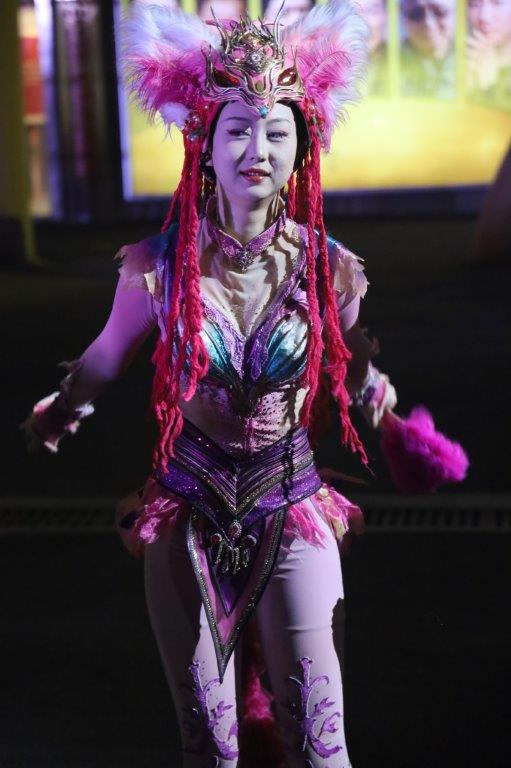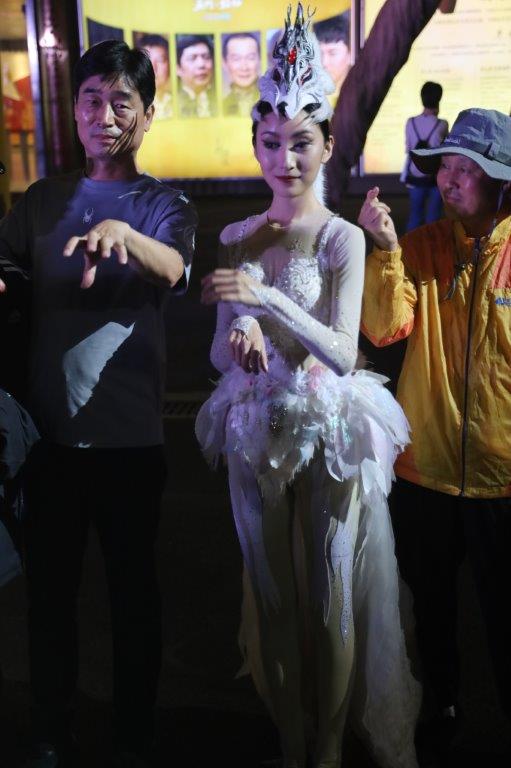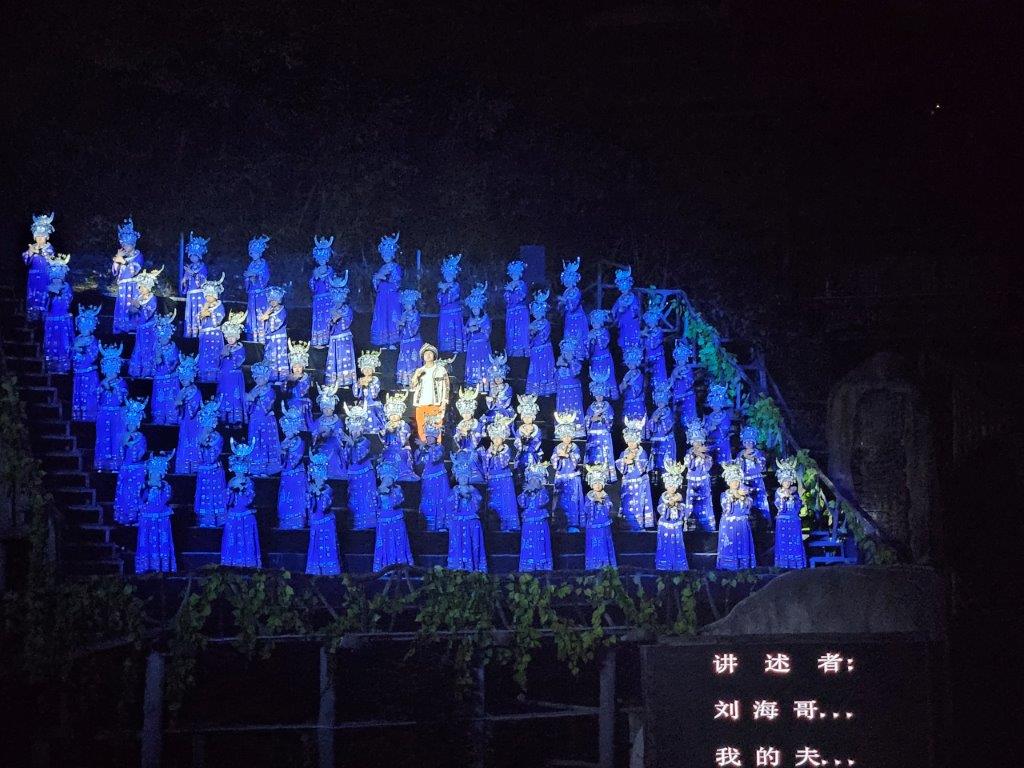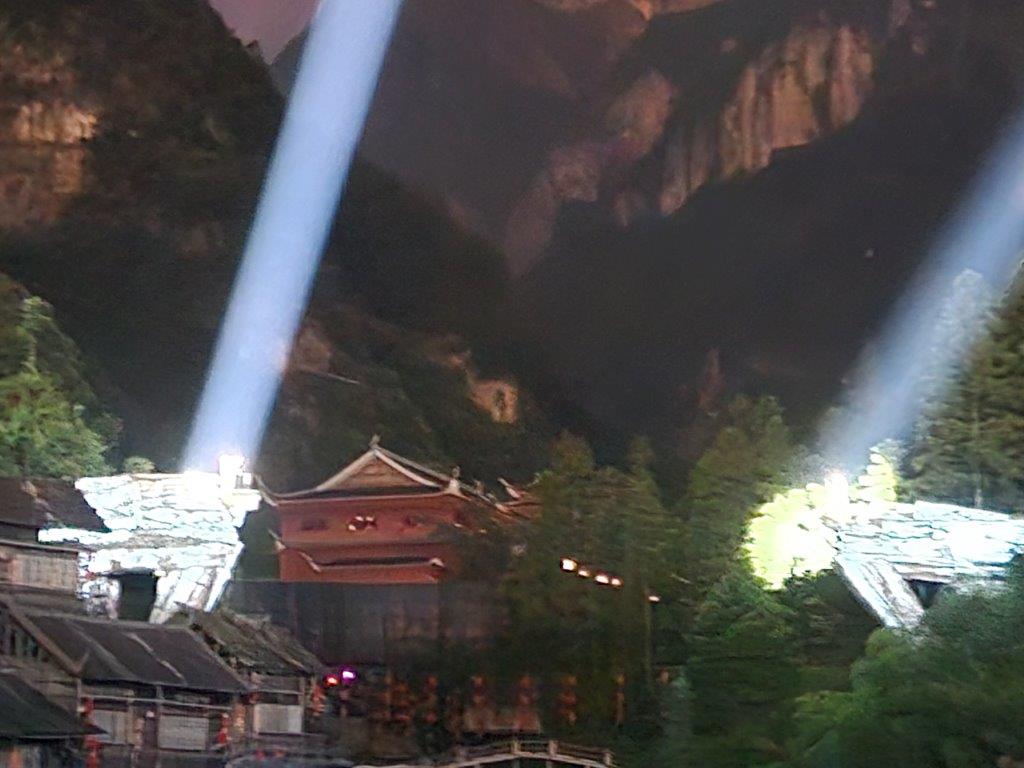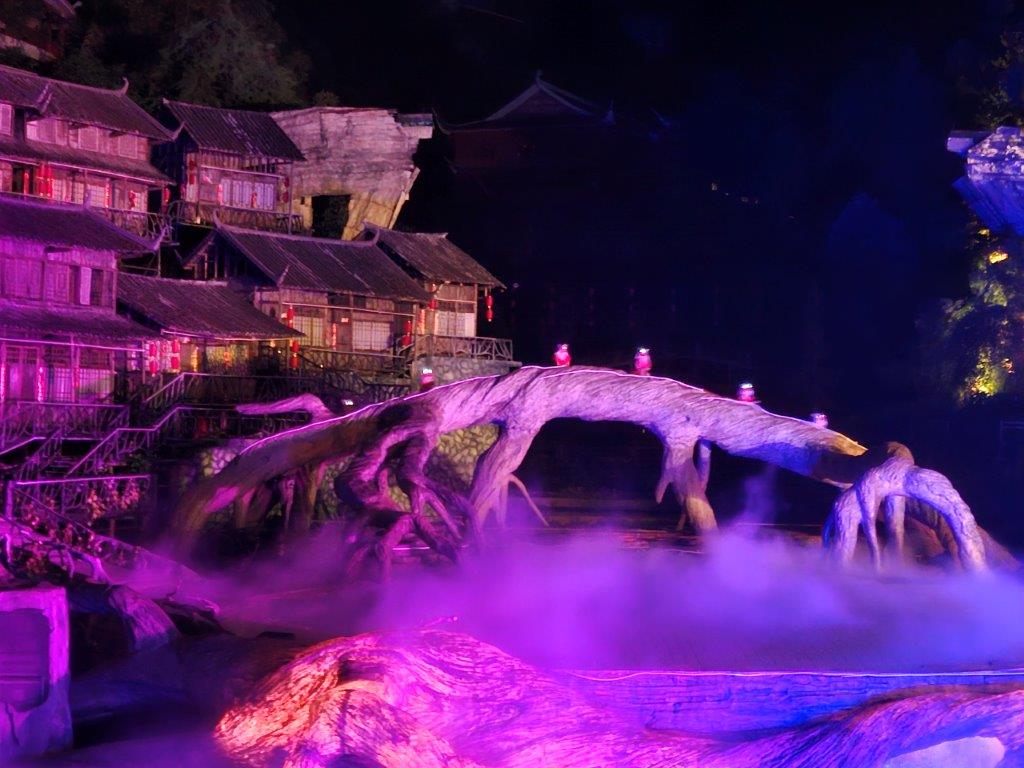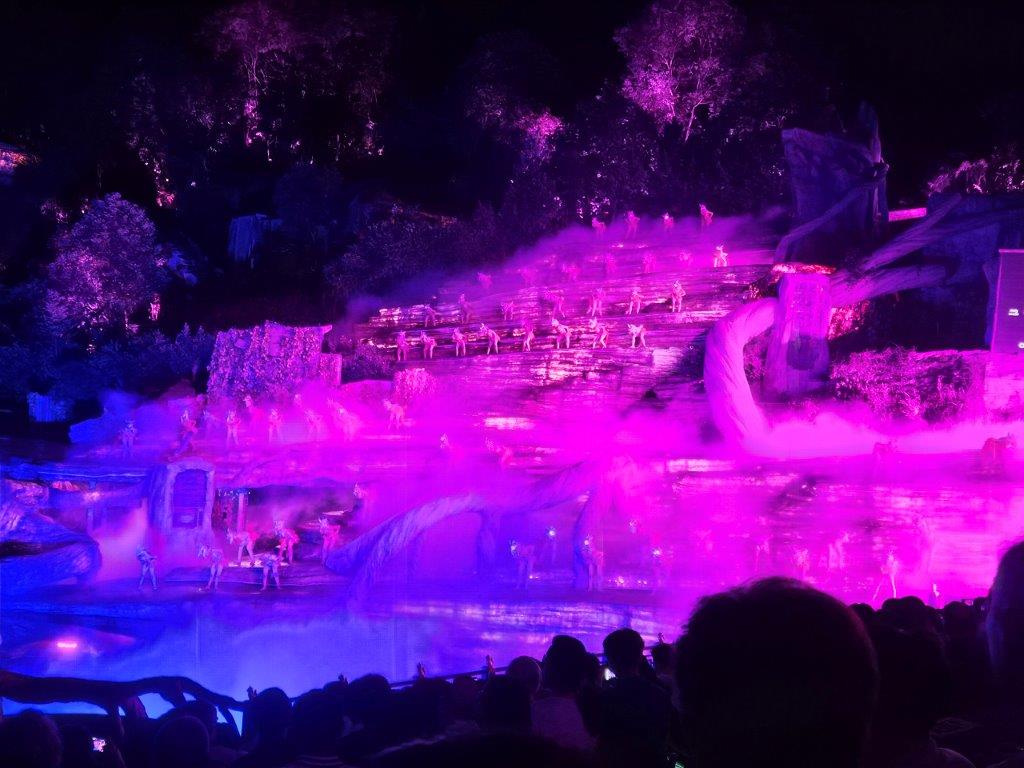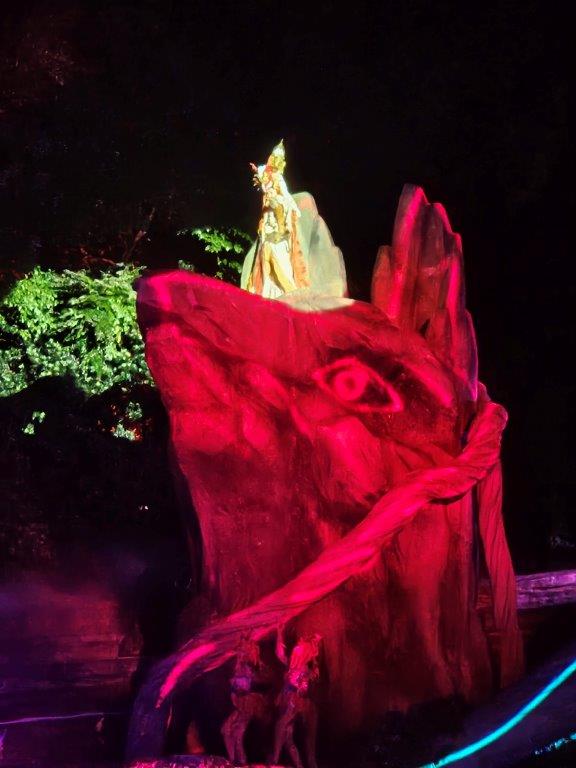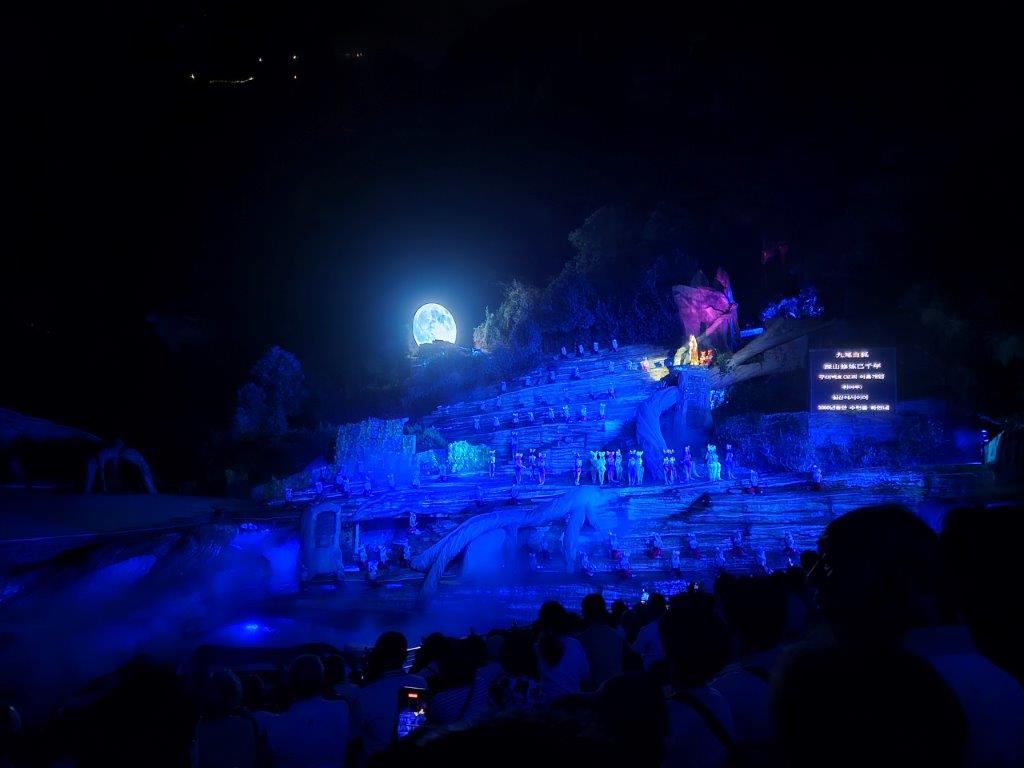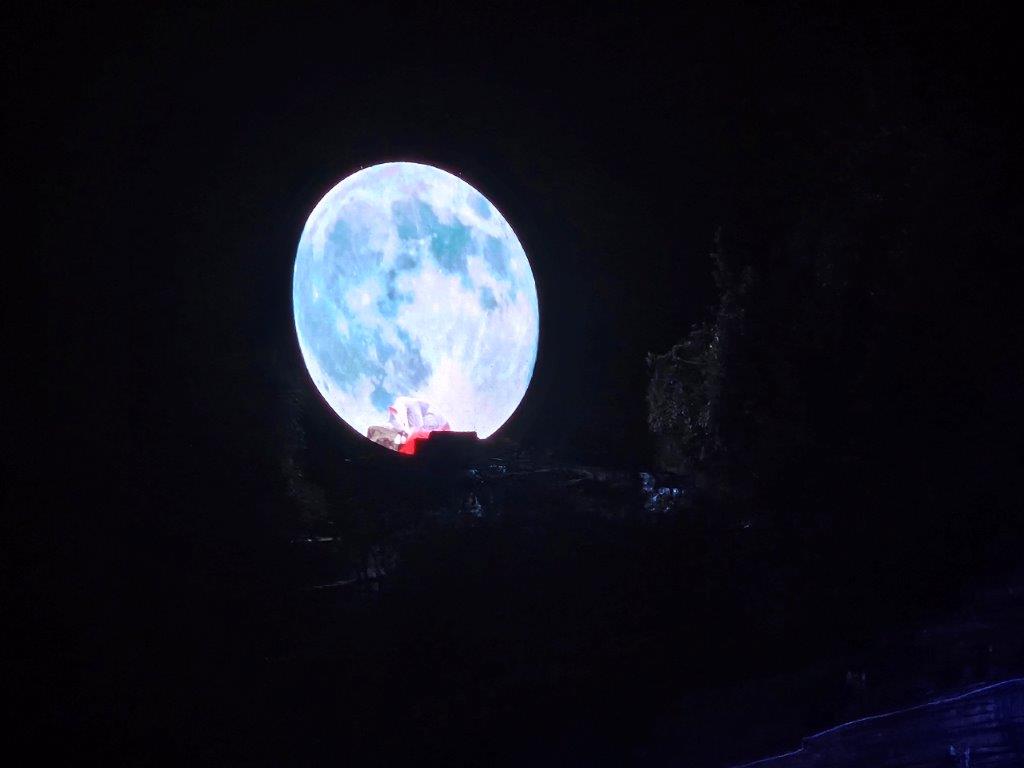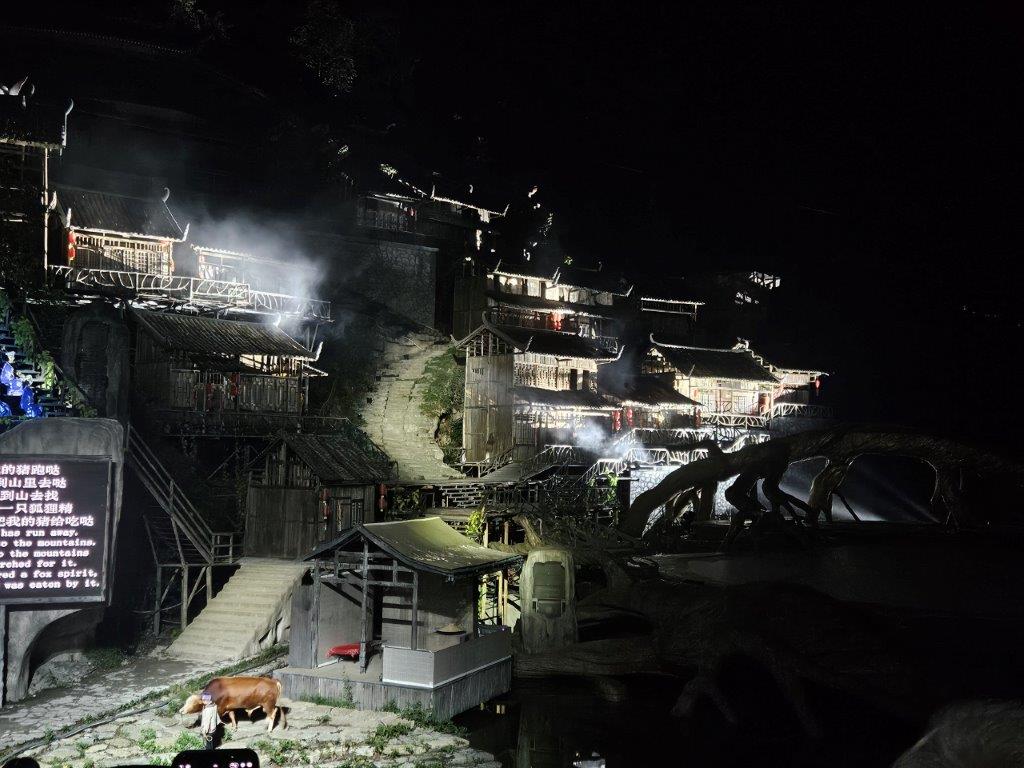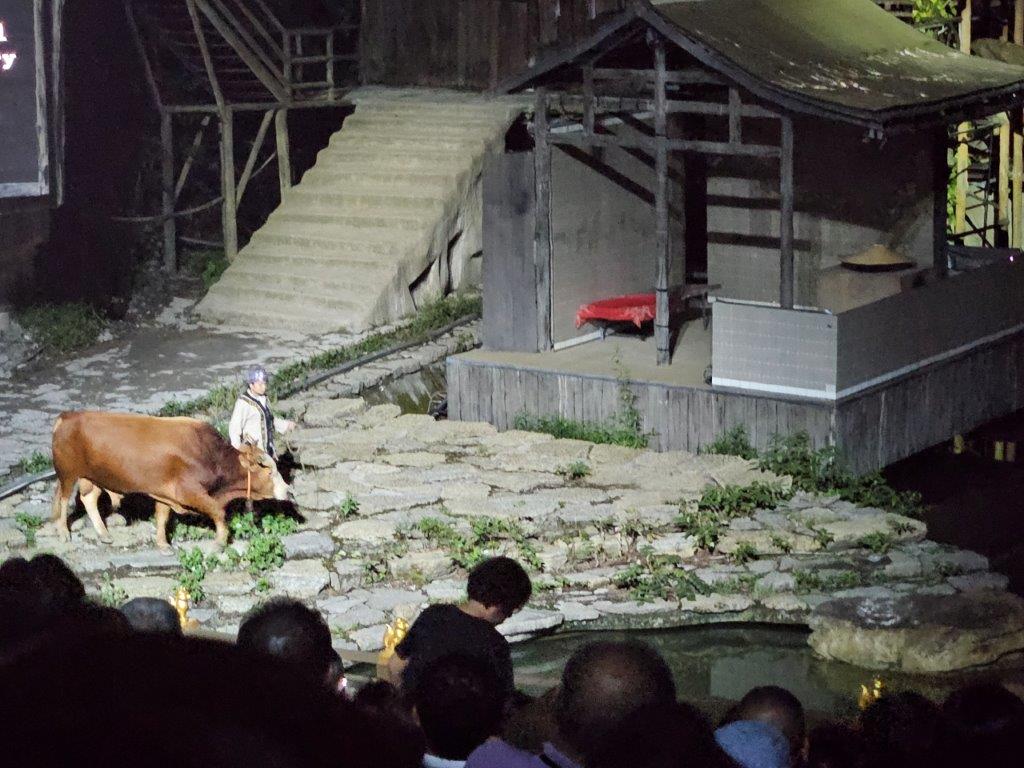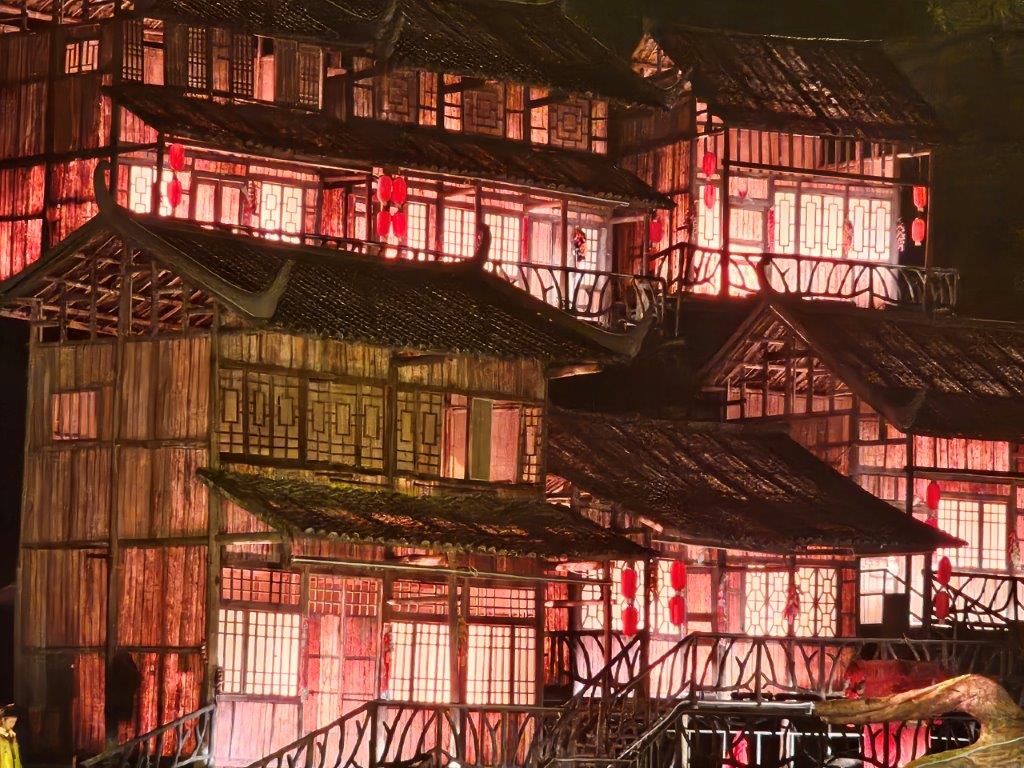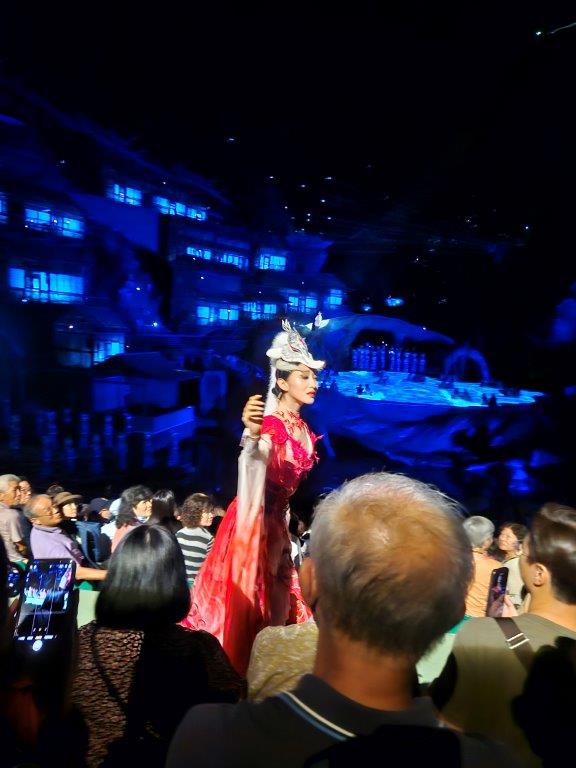23. Tianmen Mountain National Forest Park 3: Legend of the Fox Lady
After entering the taxi, we drove back to Tianmen Mountain. It was now completely dark, but the mountain was lit beautifully in a green artificial light, as we arrived at the theater entrance buildings …
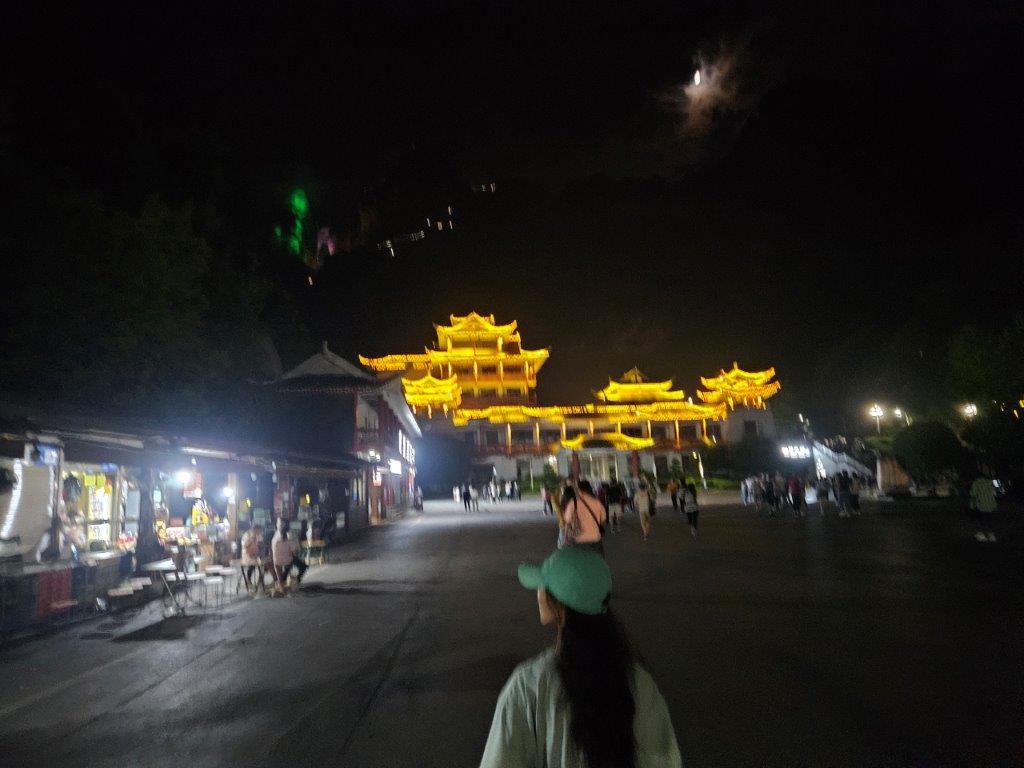 Then the light on the mountain changed into deep blue …
Then the light on the mountain changed into deep blue …
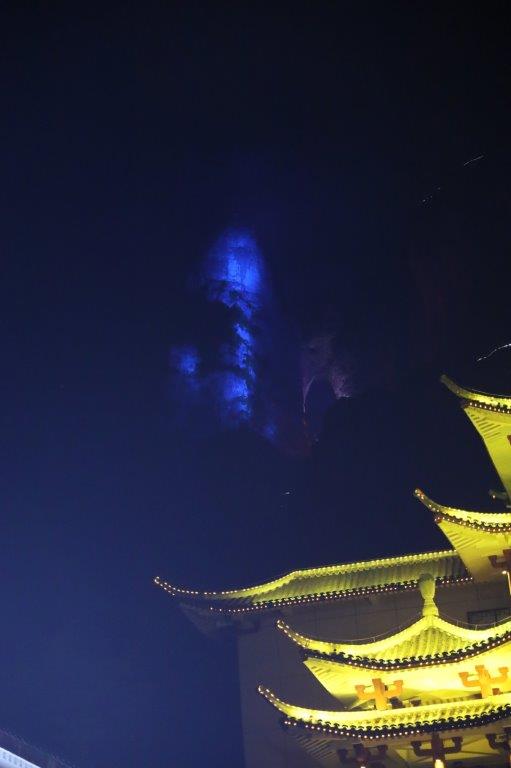 Set against the backdrop of Tianmen Mountain, the Tianmen Fox Fairy Show is a marvelous open-air play depicting an old love story between a fox fairy and a human.
Set against the backdrop of Tianmen Mountain, the Tianmen Fox Fairy Show is a marvelous open-air play depicting an old love story between a fox fairy and a human.
Some of the actors of the upcoming play, were gathered in front of the entrance and it was allowed to take photo’s..
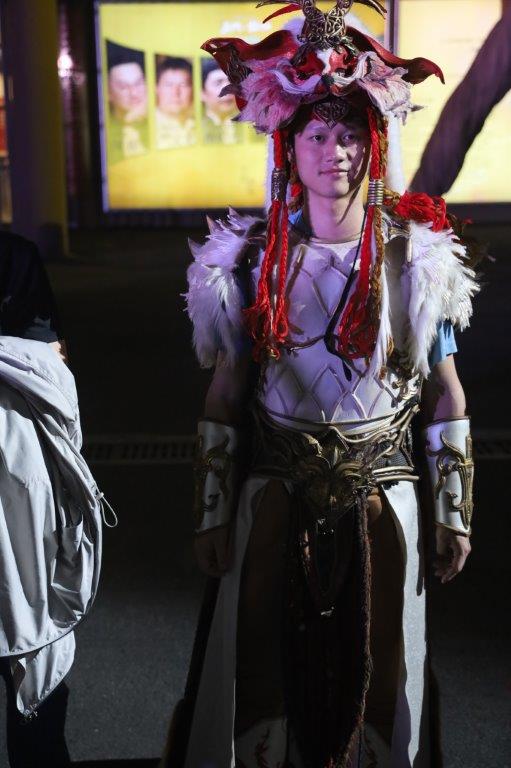 The 90-minute show features hundreds of singers and actors with excellent choreography, singing, costumes, sound, lighting, and special effects. There are big screens with English subtitles on the left and right of the stage for the foreigners who don’t understand Chinese.
The 90-minute show features hundreds of singers and actors with excellent choreography, singing, costumes, sound, lighting, and special effects. There are big screens with English subtitles on the left and right of the stage for the foreigners who don’t understand Chinese.
The show has both regular and VIP seats. While the VIP seats are higher up and thus afford a better view over the whole stage, they are farther away from the stage and make it more difficult to see the details of the show, as well as the text on the screens. The Wandelgek chose for regular seats. in 2024 show time was between 8:15 PM – 9:45 PM (daily). Ticket prices were 238 RMB to 888 RMB (depending on the seat position). If you are visiting in the winter, be sure to wear thick clothes since the show is outdoors and it can get cold at night. In case of rain, you can get a free poncho from the ticketing office.
I do not know the names of all the characters, but they looked gorgeous and it raised my expectations of the show even more …
Tianmen Fox Fairy Show is a large-scale real-scene musical drama that originated from a traditional Chinese fairy tale, which showing a love story between a fox fairy and a woodsman. The love story was widespread throughout locals and all Chinese. The performance area is located in the 5 km long valley of Tianmen Mountain, 8 km from Zhangjiajie City, Hunan Province.
Known as the world’s first real-scene musical drama with the high mountains and deep valleys as the stage background, Tianmen Fox Fairy Show was put on at the foot of Tianmen Mountain, Zhangjiajie in September, 2009. Originated from a traditional Chinese myth and folk tale – “Love between Man and Fox”, the drama integrates the elements of folk music and modern art. As the story progresses, you will find settings everywhere from the foot of the hill to the peak, be it spotlight, stage for the chorus, background houses and so on. The visual presentation is spectacular and amazing, the music is impressive, and those dancers and singers are also charming.
The Tale of the Fox Spirit explained
Imagine a fox. Not your scrawny, chicken-stealing, mud-snarled farm menace. No, this one struts into the night with fur like burnished fire, eyes sharper than daggers, and tails—plural. At first just one, but with centuries of patience, cunning, and a diet of human gullibility, it blossoms into nine magnificent tails like a royal cloak. Each tail hums with magic and mischief, practically begging to be adored.
Naturally, the fox decides to try the greatest game of all: becoming human. And not just any human, but the kind that could walk into a poetry contest, win everyone’s hearts, and slip out again without paying the bill.
The fox transforms into breathtaking maidens, refined scholars, tragic widows, dazzling nobles—anything, really, so long as it causes mortals to trip over their own feet. And oh, the humans fall for it. Entire villages lose their brightest sons, not to demons of fire or steel, but to candlelit conversations and suspiciously long walks under the moon. It’s like everyone in these tales slept through the “stranger danger” lesson.
But here’s the twist: the fox, trickster supreme, sometimes forgets it’s supposed to be tricking. A smile turns real, a caress lingers too long, and suddenly this soul-devouring seducer is doing… housework. Folding laundry! Writing love notes! Waiting by the door like some lovesick pup. The audience groans: “Oh no… it caught feelings.”
Here’s where it hurts. Because illusions crack. Whether by accident—someone sees the tails in moonlight—or by betrayal—superstitious mobs burst in with all the courage of people holding pitchforks. And then the masks fall. The fox flees, or it fights, but in both cases, somebody’s heart gets shattered. Sometimes the human dies in the draining glow of fox-fire. Sometimes, the fox vanishes, sobbing into eternity. And once in a while, folklore grants them a happy ending: a love so stubborn it withstands even the fox’s nature. But those stories are rare, like finding wine at the bottom of the jug—you mostly just end up with regret…
However, tonight’s story is such a story where in the end the White Fox Lady finds the love of a human and vice versa.
The Tale of the Fox Spirit: Love and Transformation
I. Meeting the Fox Spirit in Chinese Lore and Mythology
The fox spirit, or Huli Jing (狐狸精), is one of the most mesmerizing figures in Chinese mythology—beautiful, cunning, and mysterious. Known for slipping between the form of a fox and that of a graceful woman, the Huli Jing has captivated storytellers and audiences for centuries. Her tales are threads woven from love, deception, and the constant play between the human heart and the supernatural.
This exploration traces the journey of the fox spirit: her beginnings, her romantic bonds, her changing faces, her power of transformation, her cultural echoes, and the lasting truths hidden in her stories.
II. Ancient Roots of the Fox Spirit
The origins of the fox spirit reach back thousands of years, whispered in texts and folklore long before dynasties rose and fell. She has always carried shifting meanings:
-
Wise teacher and keeper of secrets
-
Clever deceiver weaving illusions
-
Enchantress embodying desire itself
In the Han dynasty, foxes were honored as spirits who could pass messages between worlds. By later ages, however, anxiety about desire and power turned her image darker, tied to seduction, trickery, and ruin. This shifting portrayal reveals not only fears of women’s allure, but also society’s unease with transformation and independence.
One ancient chronicle tells of a sage who welcomed a fox spirit into his home. She taught him verses that revealed the movements of the stars. Only later did the neighbors brand her as a danger, preferring suspicion to the knowledge she brought.
III. Tales of Love Between Humans and Foxes
Love has always been at the heart of fox spirit tales. Her romances with mortals unfold in many versions:
-
A wandering scholar who meets a fox maiden by moonlight and discovers devotion stronger than fate.
-
A retelling alongside the Legend of White Snake, where both serpent and fox spirits embody love that defies persecution.
-
The myth of the Nine-Tailed Fox, whose many forms both bless and destroy kingdoms in pursuit of passion.
These stories reveal love’s paradox: it heals and renews, yet also threatens and unsettles. In one tale, a scholar falls deeply for a fox woman who visits him nightly. Each evening she arrives with glowing lanterns, filling his chamber with light. But when their secret is uncovered, she vanishes, leaving behind only the lingering perfume of autumn chrysanthemums—a reminder that love can transform but never be contained.
IV. The Two Faces of the Fox Spirit
Duality defines the Huli Jing. She is at once a lover full of loyalty and a trickster who reshapes lives through deception.
-
Some tales present her as a devoted guardian, helping her beloved succeed in exams, careers, or even destiny itself.
-
Others cast her as the destroyer, entangling men in false promises or luring them into madness.
The ambiguity mirrors human relationships themselves—devotion intertwined with fear, desire woven with risk. A hunter once saved a wounded fox and nursed her back. At night she returned in human form, bringing him fortune. When greed overcame him and he demanded gold beyond reason, she disappeared in smoke. His empty hands reflected the consequences of mistrust in love.
V. Shifting Forms, Shifting Selves
If one theme defines fox spirit tales, it is transformation. Her very nature speaks of identities in motion: fox to woman, spirit to lover, illusion to truth.
-
Love is often the spark, driving change in both the spirit and her human companion.
-
These transformations reshape not only the individuals but also their families and communities.
-
Beneath it lies a deeper challenge: rigid ideas of gender, loyalty, and fate are undone by her fluidity.
In one famous version, a fox lover reveals her true form to her human partner. Instead of fear, he embraces her. In that moment, she chooses to become fully human—yet, in gaining permanence, she loses her immortality. The tale reminds us that identity is fluid, but choice fixes us in the world.
VI. The Fox Spirit in Culture
From scrolls to cinema, the fox spirit has never left the cultural imagination. She lives in:
-
Classical verses that described her eyes as autumn pools
-
Silk paintings where she strides between men and moonlight
-
Television dramas where she emerges as a heroine torn between duty and desire
One Ming dynasty painter reportedly fell ill after endlessly painting fox maidens. He swore each appeared more lifelike than the last, until at night he saw one step down from the canvas. Whether dream or truth, such stories show how deeply she is etched into culture—half myth, half mirror of our own yearnings.
VII. The Lessons She Brings
Beneath enchantment, her tales carry lessons:
-
Love’s complexity defies simple answers.
-
Sacrifice and loyalty grant true depth to relationships.
-
Transformation, painful though it may be, is the only path to renewal.
A parable speaks of a farmer who loved a fox-wife even when villagers whispered curses. When persecution grew violent, she sacrificed her spirit’s form to walk as mortal at his side. Their love endured, but at the cost of her immortality. Such stories remind us that love’s truest power is not in possession, but in what we are willing to surrender.
VIII. The Endless Legacy of the Fox Spirit
The Huli Jing endures because she is both eternal and ever-changing. Each age remakes her, but the heart of the tales remains—love’s ability to cross worlds and transform identities.
Even today, modern novels and dramas tell of fox spirits falling in love in city streets, caught between skyscrapers and tradition. The message echoes across centuries: love and transformation are not bound by time.
One final story tells of a traveler who met a fox maiden beneath blossoming plum trees. As dawn drew near, she whispered: “If you remember me, I will never vanish.” Though she disappeared with the morning light, the man carried her memory, and with it, the fox spirit’s truth—that the heart’s journeys matter more than the roads we walk.
IX The Fox Spirit in Japan
I’m quite a fan of the cinematic work of Akira Kurosawa, who’s work was also an inspiration for George Lucas’s Star Wars movies. Akira Kurosawa made a movie at the end of his directing career named: Akira Kurosawa’s Dreams. In this movie several short stories about legend connected to, destroying and living in harmony with nature are being told. The very first one is about Fox spirits which delude people by acting like wandering lights that lure a young boy deep into the forest where he gets lost forever. I was reminded by these foxes when seeing the Fox lady show at Tianmen mountain and started to think about comparisons and differences in the meaning of those foxes in both cultures.
Foxes hold significant cultural symbolism in both Chinese and Japanese legends, but their roles and attributes differ in each tradition.
| Aspect | Chinese Legend | Japanese Legend |
|---|---|---|
| Symbolism | Wisdom, cunning, and often trickery; sometimes seen as omens. | Supernatural beings, especially as shape-shifters and protectors of rice and agriculture. |
| Spirit Type | Often depicted as Huli Jing, possessing both benevolent and malevolent traits. | Known as Kitsune, with a more definitive classification into good (Inari’s foxes) and evil. |
| Transformation | Can transform into beautiful women, usually for manipulation or mischief. | Often portrayed as beautiful women who can be both affectionate and dangerous, reflecting duality. |
| Relationships | Relationships with humans vary; can lead to chaotic events but may also end in mutual benefit. | Kitsune are frequently depicted as guardians, with a notable connection to the deity Inari, providing blessings or protection to families. |
| Powers | Can wield magical abilities, often causing trouble for mortals, or bringing wisdom if treated kindly. | Possess powerful magical abilities, with older, more powerful foxes (kyūbi no kitsune) having the ability to grant wishes or control the elements. |
| Narrative Role | Frequently appears as tricksters or advisors, teaching lessons through their schemes. | Often depicted in love stories or layered narratives, embodying both the alluring and dangerous aspects of love. |
Cultural Context
In Chinese mythology, the Huli Jing can represent both virtuous and malicious traits. A Huli Jing might trick individuals for personal gain but can also provide wisdom to those deserving. This dual nature reflects a complex understanding of morality and consequences within the human experience.
In Japanese folklore, the Kitsune is revered and feared simultaneously. As messengers of Inari, they provide blessings and protection to those who honor them. However, they can also enact revenge on those who disrespect them. The duality of their nature often serves as a moral lesson about the interplay of kindness and treachery.
Summary
While both cultures attribute magical and transformative qualities to foxes, Chinese legends tend to emphasize cunning and trickery, whereas Japanese legends often celebrate the Kitsune’s role as protectors and agents of fate. The way foxes are portrayed in each tradition offers deep insights into the values and beliefs of their respective societies.
The Legend of the Fox Lady
In the mist-shrouded hills of Tianmen Mountain, a haunting tale unfurls beneath the delicate glow of the moon. It is the story of the Fox Lady, a bewitching spirit who roamed the lush valleys, intertwined with the lives of the villagers. With her mesmerizing beauty and ethereal grace, she captivated the hearts of all who crossed her path.
Centuries ago, when humans and spirits shared a fragile harmony, a young girl named Mei fell victim to a terrible fate—a loveless marriage arranged by her family. In her despair, she wandered deep into the forest, where she encountered the Fox Lady, a creature of wisdom and magic. Recognizing Mei’s plight, the Fox Lady offered her a deal: she would grant Mei the power to transform into a fox, allowing her to escape her dreary life.
As dusk settled each night, Mei would transform, exploring the world through the Fox Lady’s eyes. In her new form, she danced through the moonlit woods, free from the burdens of her past. Yet, the bond between the two grew deeper; the Fox Lady, once a mere spirit, found solace in Mei’s companionship.
However, darkness loomed on the horizon. A jealous sorcerer, tracing the whispers of their bond, sought to capture the Fox Lady for his dark schemes. With her cunning and grace, the Fox Lady defended herself and Mei, leading them into a final confrontation atop Tianmen Mountain.
In a breathtaking spectacle of light and shadow, the spirit unleashed her powers, a dazzling display of nature’s fury and beauty. The sorcerer was vanquished, but in the aftermath, a choice lay before Mei. To remain a fox and roam free by the Fox Lady’s side or to return to her life among the villagers.
Choosing freedom, Mei vanished into the night, forever entwined with the spirit of the Fox Lady. The echoes of their laughter still reverberate through the valleys, a reminder that some bonds transcend the boundaries of flesh and spirit, igniting the imagination of all who visit Tianmen Mountain in search of wonder.
This legend continues to be performed, a timeless tale of love, sacrifice, and the pursuit of freedom that enchants visitors, making the mountain a living canvas of history and folklore.
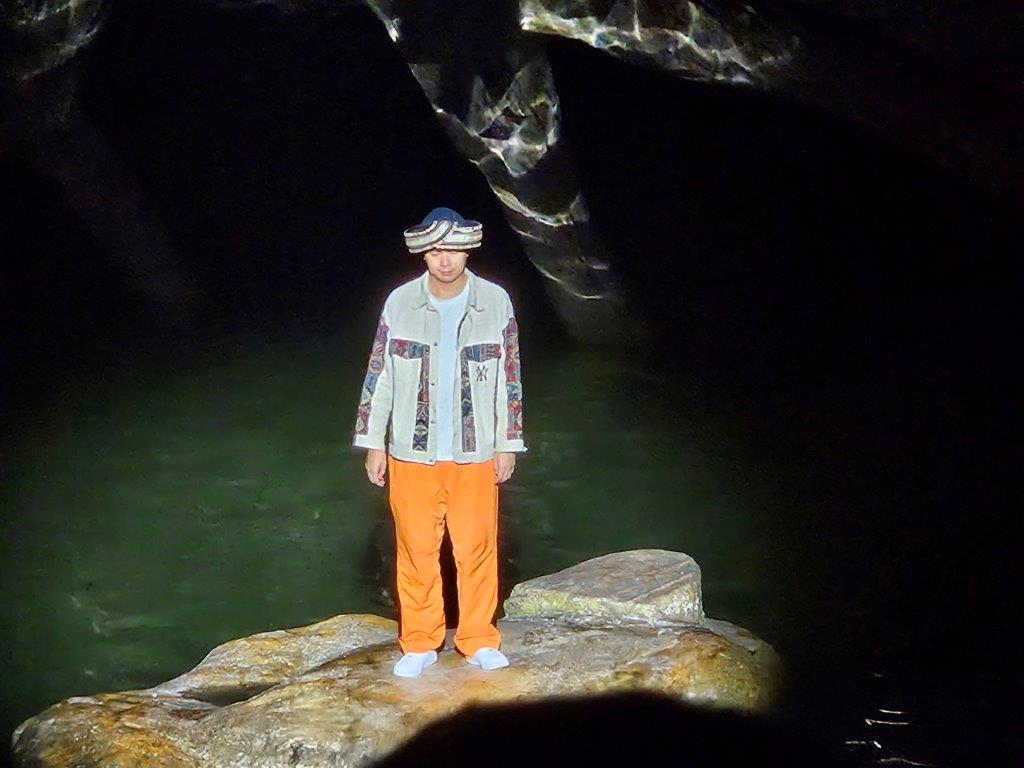 The Fox Lady and Tianmen Mountain
The Fox Lady and Tianmen Mountain
The legend of the Fox Lady continues to resonate with visitors to Tianmen Mountain, where performances and artistic representations breathe life into this enchanting tale. It serves as a reminder of the complexities of love, the fight against societal constraint, and the beauty of courage in seeking one’s true path.
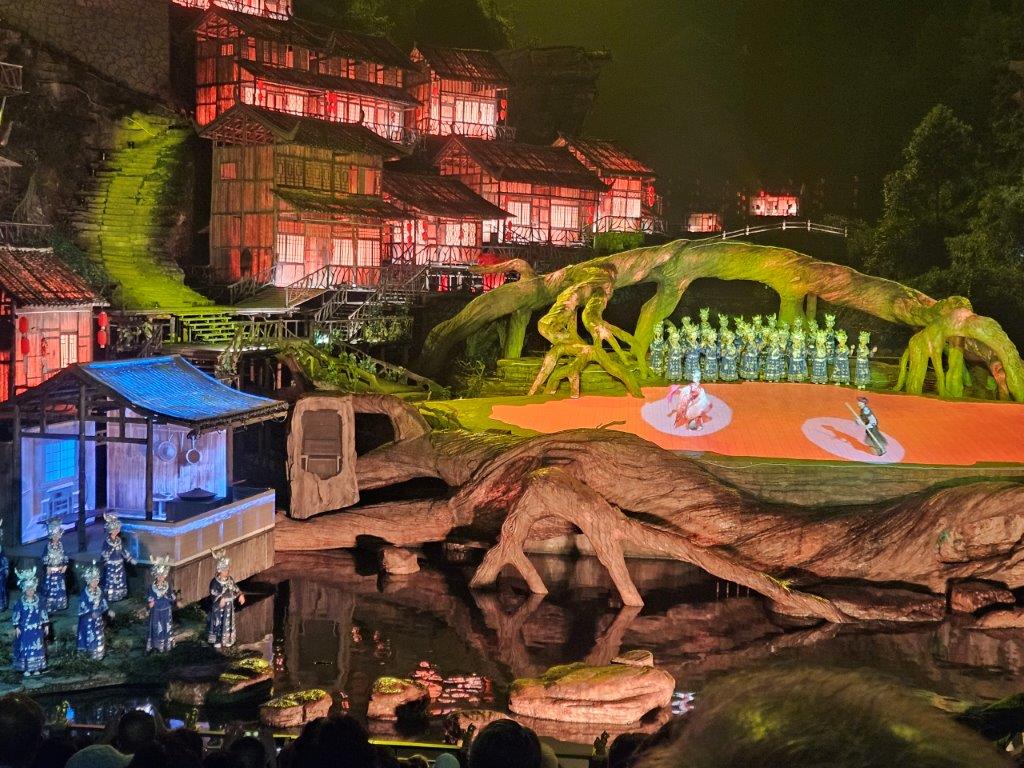 This captivating story not only enriches the cultural tapestry of the region but also draws tourists and storytellers alike, making Tianmen Mountain a site of both natural beauty and mythical allure.
This captivating story not only enriches the cultural tapestry of the region but also draws tourists and storytellers alike, making Tianmen Mountain a site of both natural beauty and mythical allure.
The Wandelgek’s opinion of the show
The Wandelgek loved the fact that the story was summorized in English language on screens. This really supported understanding of the story and the screens were not disruptive in any way either.
The actors were dressed beautifully and the decors were amazing. There was this beautiful country side village, a large pool and the mountain backdrop. Added to that were special effects, like a moving mountain bridge that joined together and cinematic effects which changed the characters using magic. The music (orchestra and choir) was great too.
If you like to know more about Chinese legend, this is a must see! Legend is always entwined in culture, language and in customs, not just in China but everywhere and it makes you better understand a culture. The Wandelgek just loves exploring legends, like the one of The Monkey King and his Journey to the West or that of the one of the Goddess Bixia Yuanjun. The legend of the Fox Lady was no exception.
Zhangjiajie Town by Night
After the show, The Wandelgek was driven home, from Tianmen Mountain to Zhangjiajie Town and his hotel.
Gaby (the guide) agreed upon an early pick up time for the next morning, because these were the last hours in Hunan and tomorrow The Wandelgek would resume his train journey through China. Then The Wandelgek went up to his hotelroom, to pack, to shower and to sleep, dreaming about the Fox Lady …
Conclusion:
The stay at Wulingyuan and Tianmen National Parks had been nothing short of completely awesome. The Wandelgek had high expectations when arriving here and they were fullfilled. That’s why it is quite strange that not so many Europeans visit these areas. Yes the National Parks are the most expensive of China and yes this is deep into China and yes it is a bit out of the routes to other highlights of Chins, but nonetheless a visit of a couple of days is more than worth doing so. For me it was a long time wish coming true.
Read my upcoming blogposts for my next China railway travels!

